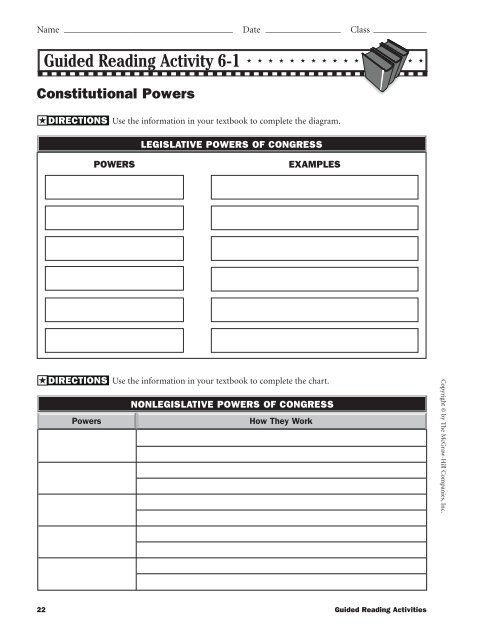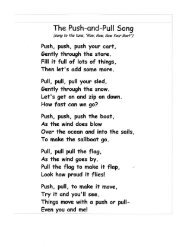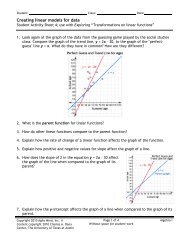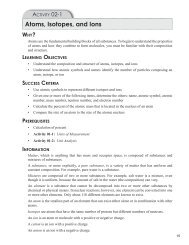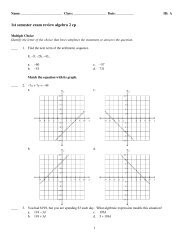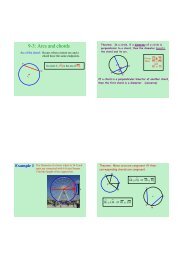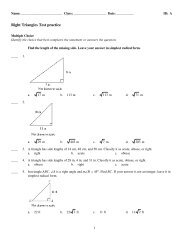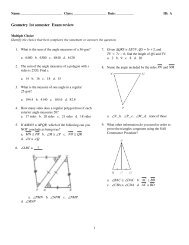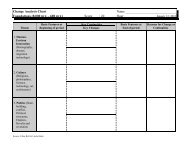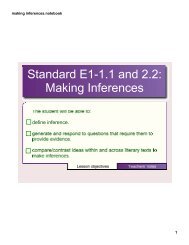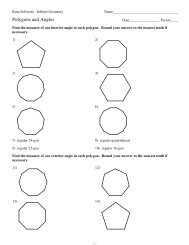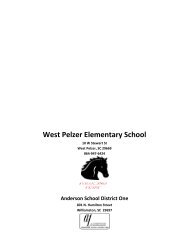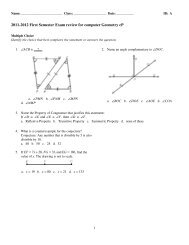Guided Reading Activity 6-1
Guided Reading Activity 6-1
Guided Reading Activity 6-1
You also want an ePaper? Increase the reach of your titles
YUMPU automatically turns print PDFs into web optimized ePapers that Google loves.
Name Date Class <br />
<strong>Guided</strong> <strong>Reading</strong> <strong>Activity</strong> 6-1<br />
Constitutional Powers<br />
★ DIRECTIONS Use the information in your textbook to complete the diagram.<br />
LEGISLATIVE POWERS OF CONGRESS<br />
POWERS<br />
EXAMPLES<br />
★ DIRECTIONS Use the information in your textbook to complete the chart.<br />
NONLEGISLATIVE POWERS OF CONGRESS<br />
Powers<br />
How They Work<br />
Copyright © by The McGraw-Hill Companies, Inc.<br />
22 <strong>Guided</strong> <strong>Reading</strong> Activities
Name Date Class <br />
<strong>Guided</strong> <strong>Reading</strong> <strong>Activity</strong> 6-2<br />
Investigations and Oversight<br />
★ DIRECTIONS Use the information in your textbook to complete the chart by listing three congressional<br />
investigative powers that are similar to those of a court and explaining why these powers are effective.<br />
Powers<br />
CONGRESSIONAL INVESTIGATIVE POWERS<br />
Why They Are Effective<br />
★ DIRECTIONS Use the information in your textbook to complete the chart. Then list ways Congress<br />
exercises its oversight power.<br />
Copyright © by The McGraw-Hill Companies, Inc.<br />
LEGISLATIVE OVERSIGHT: AN EXAMPLE OF CHECKS AND BALANCES<br />
Branch of Government Function Way to Exercise Checks and Balances<br />
Congress<br />
The Executive Branch<br />
List three ways Congress exercises its oversight power.<br />
1. <br />
2. <br />
3. <br />
<strong>Guided</strong> <strong>Reading</strong> Activities 23
Name Date Class <br />
<strong>Guided</strong> <strong>Reading</strong> <strong>Activity</strong> 6-3<br />
Congress and the President<br />
★ DIRECTIONS Use the information in your textbook to complete the diagram.<br />
CAUSES OF CONFLICT BETWEEN CONGRESS AND THE PRESIDENT<br />
Example Example Example Example<br />
★ DIRECTIONS Use the information in your textbook to complete the chart. First, list the two important<br />
areas in which Congress has recently gained power over the executive branch. Below the area titles, briefly<br />
describe how Congress has accomplished each task.<br />
Effort:<br />
SUCCESSFUL CONGRESSIONAL EFFORTS TO CURB EXECUTIVE POWER<br />
How Accomplished<br />
Effort:<br />
How Accomplished<br />
Copyright © by The McGraw-Hill Companies, Inc.<br />
24 <strong>Guided</strong> <strong>Reading</strong> Activities
Name Date Class <br />
<strong>Guided</strong> <strong>Reading</strong> <strong>Activity</strong> 7-1<br />
How a Bill Becomes Law<br />
★ DIRECTIONS Use the information in your textbook to complete these sentences.<br />
BILLS AND RESOLUTIONS<br />
Copyright © by The McGraw-Hill Companies, Inc.<br />
1. usually deal with individual people or places.<br />
2. apply to the entire nation. They may be controversial, dealing with such<br />
issues as , , or .<br />
3. deal with internal matters of only one house of Congress.<br />
4. When both houses of Congress agree, they may pass a , for example to correct<br />
an error in an or to for a special purpose.<br />
5. , on the other hand, do not have the force of law and do not require the<br />
president’s signature. Yet, to take effect, of Congress must pass them.<br />
6. Fewer than 10 percent of the bills introduced in Congress become public laws. Three reasons that so few<br />
bills become laws are: <br />
<br />
7. The ideas for new bills may come from , ,<br />
, or officials in the branch.<br />
8. To introduce a bill in the House, a member must .<br />
9. To introduce a bill in the Senate, .<br />
★ DIRECTIONS Use the information in your textbook to define the following terms:<br />
INTRODUCING A BILL<br />
A. pigeonholing F. recorded vote <br />
<br />
B. hearings G. role-call vote <br />
<br />
C. quorum H. veto <br />
D. voice vote I. pocket veto <br />
<br />
E. standing vote J. line-item veto <br />
<br />
<strong>Guided</strong> <strong>Reading</strong> Activities 25
Name Date Class <br />
<strong>Guided</strong> <strong>Reading</strong> <strong>Activity</strong> 7-2<br />
Taxing and Spending Bills<br />
★ DIRECTIONS Use the information in your textbook to complete the chart.<br />
HOUSE AND SENATE INFLUENCE ON TAX BILLS<br />
House<br />
Senate<br />
Name of Committee<br />
Name of Committee<br />
What It Does<br />
What It Does<br />
★ DIRECTIONS Use the information in your textbook to complete the chart.<br />
HOW HOUSE AND SENATE APPROPRIATE MONEY<br />
House and Senate Committees<br />
Committee Name<br />
What They Can Do<br />
Copyright © by The McGraw-Hill Companies, Inc.<br />
What They Cannot Do<br />
26 <strong>Guided</strong> <strong>Reading</strong> Activities
Name Date Class <br />
<strong>Guided</strong> <strong>Reading</strong> <strong>Activity</strong> 7-3<br />
Influencing Congress<br />
★ DIRECTIONS Use the information in your textbook to complete the diagram. Identify the individuals<br />
and groups that influence lawmakers. Write one influential person or group on each arrow.<br />
MAJOR INFLUENCES ON LAWMAKERS<br />
SENATOR<br />
OR<br />
REPRESENTATIVE<br />
★ DIRECTIONS Match the political parties with the issues they support. Check the line under the name<br />
of the political party that usually supports each type of issue.<br />
Copyright © by The McGraw-Hill Companies, Inc.<br />
THE INFLUENCE OF PARTY POLITICS ON COMMON ISSUES<br />
Republicans<br />
Democrats<br />
help for low-income people and projects <br />
limited government intervention in the economy <br />
less government spending<br />
social welfare programs <br />
greater government regulation of business <br />
job programs through public works <br />
less government regulation of business <br />
local and state, rather than national, solutions to problems <br />
<strong>Guided</strong> <strong>Reading</strong> Activities 27
Name Date Class <br />
<strong>Guided</strong> <strong>Reading</strong> <strong>Activity</strong> 7-4<br />
Helping Constituents<br />
★ DIRECTIONS Use the information in your textbook to complete the chart.<br />
LEGISLATORS’ CASEWORK<br />
Examples of Casework<br />
Purposes of Casework<br />
★ DIRECTIONS Use the information in your textbook to complete the diagram. Give an example of<br />
each of the ways in which legislators bring federal money and projects into their states.<br />
BRINGING HOME THE BACON: HOW LAWMAKERS WORK FOR THEIR STATES’ SHARE<br />
Pork-Barrel Federal Grants and Keeping Federal<br />
Legislation Contracts Projects<br />
Copyright © by The McGraw-Hill Companies, Inc.<br />
28 <strong>Guided</strong> <strong>Reading</strong> Activities


